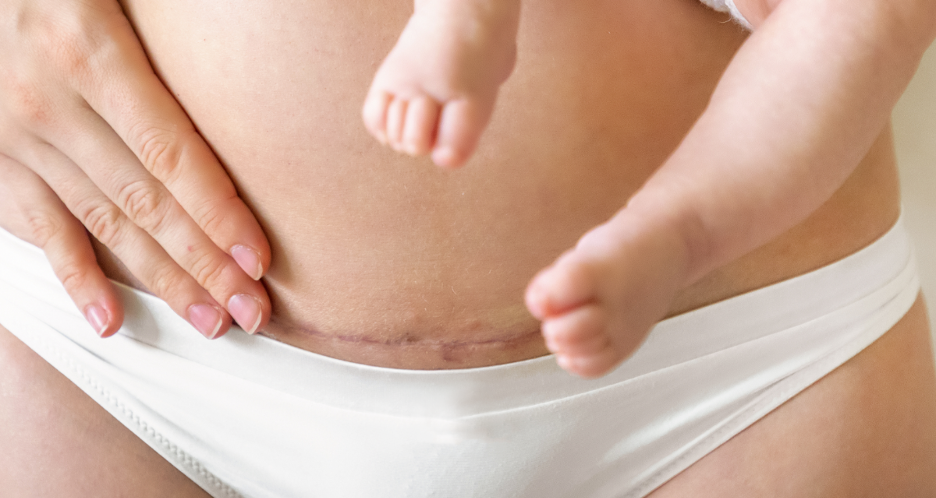C-Section Births: an Ob/gyn weighs in

Hey, mamas - Happy Cesarean Awareness Month! Yep, it's a thing. We typically say the way babe comes into the world is not the main event (the adorable tiny human you created is!). However, if their way out of the womb happens to be lifesaving, that's all the more reason to celebrate. While up to 30% of U.S. babies are born via C-section, there are still plenty of misconceptions around them, like...
Myth #1: Every body was made for a vaginal birth.
Myth #2: C-section recoveries are always harder.
Myth #3: Once a C-section, always a C-section.
As you approach your due date, we want you to be prepared as possible for what can go down, given that the need for a C-section often presents itself close to labor, if not during it (first mamahood lesson: let go of what ya can't control). In case a planned or unplanned C-section is in your future, we wanted you to be as prepared as possible so we brought in the expert.
Dr. Samantha Berg is a mom of one and board certified OB/GYN who practices in San Diego, CA. She's here to walk you through all things belly-births so you can expect the unexpected. What better month to dispel some of these C-section myths? You got this, mama...
Q+A with dr. berg
First thing’s first: What is a C-section?
A cesarean section (C-section) is delivery of a baby through abdominal surgery and an incision made in the uterus.
A few examples of reasons for a C-section include breech presentation, failure of labor to progress, concerns for wellbeing of the baby (often from the fetal heart rate monitor), placental issues (such as placenta previa), previous C-section, and multiple gestation.
What are the chances of having a C-section?
The primary cesarean section rate in the United States is anywhere from 20 to 30%.
If you have had a prior vaginal delivery, you can often have another vaginal delivery. However, there are indications, like some that I mentioned, that could require a C-section in subsequent pregnancies.
Do your patients ever elect for one?
Yes, patients sometimes elect for a cesarean section. I always have a comprehensive discussion with my patients to discuss the decision, the reason they are interested in an elective C-section, and the risks involved with surgery.
Can you walk us through what to expect?
For a scheduled C-section, patients often check in to the hospital a couple of hours before the scheduled time. During that time, an IV is placed, labs are drawn, the baby is put on the fetal heart rate monitor, and patients meet with the OB/GYN and anesthesiologist and consent to the procedure and make sure all questions are answered. Usually the anesthesia is performed in the operating room.
For an unplanned C-section (one that occurs during labor), if you have an epidural in place, that is usually used for the anesthesia for the C-section. It is rare to need general anesthesia (asleep during the C-section), otherwise you are awake during the procedure.
After the C-section, the hospital stay is typically 3 nights (vaginal birth hospital stay is usually 2 nights).
Can your birthing partner have a role in supporting you?
In most cesarean deliveries your birthing partner can be in the operating room right next to you. This can be really comforting during the delivery and you get to experience the birth together. In some emergent situations the birthing partner might not be able to be in the room, but these cases are rare.
Can you do skin-to-skin or breastfeed immediately after?
Usually there is baby team present who immediately makes sure the baby is doing well. If all is well, baby is typically brought over to mom to get skin-to-skin. If patients plan to breastfeed, this is most often initiated right after the C-section in recovery.
How does the recovery differ from vaginal births?
It is normal during recovery to have cramping (especially with breastfeeding), pain in the incision, and vaginal bleeding for 4-6 weeks. Usually the hardest part of the recovery is the first week. When I see my patients at their two-week follow-up visit they typically are only occasionally taking ibuprofen or Tylenol. Recovery from a cesarean birth is not always harder than a vaginal birth.
What are your best tips for healing post-C-section, especially if you have a toddler at home?
I am a big fan of abdominal binders (they often can give you one at the hospital). I find that they provide a lot of comfort/support. Showering every day is a great 10 minute “mom break” and will also help keep the incision clean. Going on walks is also really helpful and important for healing. It is really important that you do not lift anything heavier than your newborn. With a toddler at home, prepping your kiddo that you won’t be carrying them for a little while can be helpful.
What advice do you have for women planning a VBAC?
A Trial of Labor After Cesarean (TOLAC) is labor after you have had a prior C-section and a Vaginal Birth After Cesarean (VBAC) is a vaginal delivery after a previous cesarean. If you are interested in a TOLAC it is important to talk to your OB/GYN early in your prenatal care. It is important to talk about benefits and risks. Additionally, there is a calculator we often use to predict chance of a successful VBAC that can be really helpful in the discussion with your doctor.
Dr. Berg is a board certified OB/GYN who completed her medical degree at Keck School of Medicine of the University of Southern California. She then completed her internship and residency at the University of Southern California/LAC+USC Medical Center. Dr. Berg’s private practice specializes in comprehensive healthcare for women, including obstetrics and general gynecology. She practices in San Diego where she currently resides with her husband and one-year-old son.







